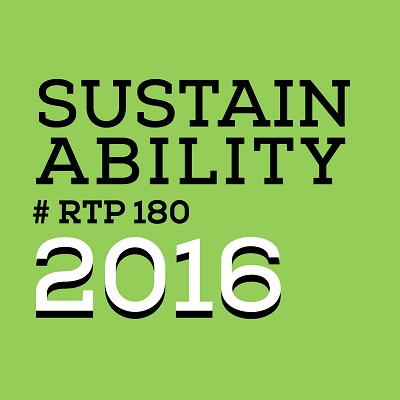
I thought I was saving the world by sorting my plastics and cans into the blue bin at the house, but in reality recycling is just the tip of the iceberg when it comes to preserving and sustaining our environment. Don’t get me wrong, you shouldn’t stop recycling by any means, but our five speakers at this month’s RTP 180 put my recycling habits to shame with their research and inventions. From growing super plants under colored light to solving the world’s energy grid crisis with inventions, these speakers know a thing or two about sustaining our environment and quality of life.
Andrew Geller from the US EPA kicked off our night by launching into a childhood story about the brook in his back yard. He went on to draw a parallel between the brook in his childhood backyard to Procter Creek in Atlanta, Georgia – both of which have an important and impactful role in their communities. Procter Creek is surrounded by a community high with crime, prone to flooding, and contained a water quality that wouldn’t pass anyone’s test, let alone the EPA’s. The community came together and formed Park Pride, a group dedicated to improving the overall quality of life for everyone in the community, which is the ultimate goal of sustainability. Their solution was to install green Infrastructures aka structures that mimic natural green resources. The results of their efforts created a complete 180 (see what I did there) in the community. To hear all of the results, you’ll have to watch Andrew’s video HERE.
Next to take the stage was Katie Martin from NC State University, who has a passion for Natural Resources in the Anthropocene (that means ‘relating to or denoting the current geological age, viewed as the period during which human activity has been the dominant influence on climate and the environment’). Katie shocked the audience by coming out of the gate with “I’m not so sure I believe in sustainability” (audience gasp) but then finishes the statement by saying “sustain implies that things remain the same, but most of my research shows that things change so I like to use the word adaptability.” Katie’s driving interest is to understand what we as humans are going to do in order to ensure that future generations have a high quality of life. Questions like, whether high quality fresh water will be in the right place at the right time is increasingly uncertain. To see more questions that keep Katie up at night, watch her 180 video HERE.
Ricardo Hernandez from the Department of Horticultural Science at NC State University is up next to school us on the power of light when growing plants indoors. Who knew the color of light could affect the growth of a plant? I certainly didn’t, but through Ricardo’s research he is able to determine which color of light sparks the most growth. By tampering with the light color, Ricardo can also control the amount of nutrition the plant produces, in something such as a head of lettuce. The outcome of his research has led to a startup creating and using grafted seedlings to produce the ultimate plant. Watch Ricardo’s video to see how this impacts the future farmers and researchers that go through NC State’s program HERE.
Now it’s time to talk dirty, at least that’s what Jorge Montezuma from the NC Department of Environmental Quality claimed he was going to do with his five minutes on stage. The average American throws away 40% of food which ends up in our local landfills. Food waste also comes from restaurants and grocery stores. We as consumers expect the grocery store to be stocked with the best produce. If we find a freckle or even a small wrinkle, we will pass over that piece of produce for another. Eventually, all the passed over pieces are tossed out and become waste. The same thing happens in restaurants: we expect the restaurant to be fully stocked and ready to cook anything on the menu from the time they open until the time they close. This also creates a lot of food waste. Fortunately, we have a few local organizations like Food Shuttle helping to reduce the amount of waste but the ultimate way we can battle food waste that is the most beneficial to the environment is through composting. Watch Jorge’s video to learn about the amazing ways compositing increases sustainability HERE.
Chris Doefler, co-founder of 3DFS Solutions ended the evening talking about electricity sustainability. Electricity, much to the audience’s surprise, is not precisely measured but is actually calculated bases on averages. Due to heat and vibration, we experience a lot of electrical loss which is a big problem because it costs a ton of money. While this is a big problem, it’s not the biggest when it comes to electricity. The biggest problem we face is an instability in the electrical grid. Heat and vibration are just symptoms of the instability. At 3DFS, Chris and his team have developed a way to accurately measure electricity to help combat the amount of electricity loss and waste. Their system will be able to harness the largest untapped energy resource known to man by unlocking the waste that is already in our electrical system. The end result being a sustainable electricity system. Watch Chris explain the 3DFS system HERE.
Now you understand why I felt like recycling was like finger painting compared to the masterpieces these brilliant minds at RTP are working on? Perhaps we witnessed the next breakthrough in sustainability! Be sure to join us next month as we invite another set of brilliant minds to discuss drug development at The Frontier in Research Triangle Park.